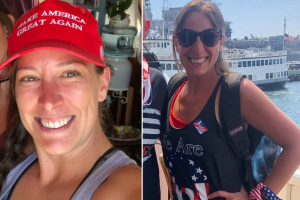
On January 6, 2021 an out-of-control group of (mostly, but not all) supporters of President Trump “stormed the Capitol” building in Washington, D.C. And though Democrats and the media falsely claimed that a Capitol police officer was mercilessly bludgeoned to death, only one person died that day on the Capitol grounds as a result of a homicide — 14-year Air Force veteran, Ashli Babbitt. There has been virtually no outrage over the shooting death of this 5’2″ 110 pound, unarmed woman by a U.S. Capitol Police (USCP) lieutenant.
For the last six months, the name of the USCP officer who shot Babbitt has been unknown except to Congressional leadership, law enforcement and some in the media. New information has surfaced within the last few weeks regarding the (public) identity of her killer which still remains formally withheld by the USCP.
Paul Sperry of Real Clear Investigations has recently publicized the name of the officer who fired the fatal shot. This article will say who he likely, not confirmed, is but mostly focus on what transpired at the scene in the seconds leading up to her unjust death along with inconsistencies in the shooter’s story.
Ashli Babbitt was the victim of a personally fatal decision to raid the Capitol, extremely poor judgement on the part of the shooter, poor communication within the USCP and very unlucky timing.
Some of the many questions that need answers: Was the lethal action legally justified or was it pure negligence? Did the officer who shot Babbitt follow training protocols or did he act improperly and impulsively?
One fact will be made very clear. Though some USCP officers were clearly wired for inter-organization communication, an astonishing lack of coordination between the shooter and other officers within just a few feet of Babbitt contributed enormously to her death.
And finally, one major question cannot be ignored. Given our highly politicized and now “racialized” culture that permeates every aspect of society since the murder of George Floyd, was there a racial component to prosecutors’ decision not to criminally charge the officer?


